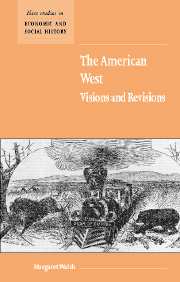Book contents
- Frontmatter
- Contents
- List of maps
- List of tables
- Acknowledgements
- 1 The frontier and the west: realities, myths and the historians
- 2 Land and landscapes: occupation and ownership
- 3 Peoples and migrations
- 4 Making a living: early settlements and farming
- 5 Making a living: non-farming occupations
- 6 Western communities
- Epilogue
- References
- Index
- More Titles in the New Studies in Economic and Social History Series
2 - Land and landscapes: occupation and ownership
ownership and occupation
Published online by Cambridge University Press: 05 June 2012
- Frontmatter
- Contents
- List of maps
- List of tables
- Acknowledgements
- 1 The frontier and the west: realities, myths and the historians
- 2 Land and landscapes: occupation and ownership
- 3 Peoples and migrations
- 4 Making a living: early settlements and farming
- 5 Making a living: non-farming occupations
- 6 Western communities
- Epilogue
- References
- Index
- More Titles in the New Studies in Economic and Social History Series
Summary
Land has always been abundant in the United States regardless of who perceives this resource. For the original inhabitants, whether as hunting, gathering, fishing, trading or agrarian communities, it was possible to occupy, survive and thrive for many years and there were still hundreds of thousands of acres not used. For European immigrants, land seemed plentiful, especially when compared to its scarcity in their original homelands. Furthermore, it was fertile land and once used for intensive farming it could yield an improved standard of living. It was also frequently beautiful as landscape and as such attracted the attention of artists and environmentalists, who wanted to conserve it as a natural wilderness for their and future generations. The ownership and occupation of western land was both desired and then contested by many peoples.
Native peoples on the land
No historian fully appreciates or can identify the varieties of landscapes that existed when Native Americans first inhabited the North American continent some 12,000 years ago. Anthropologists, geographers, ethnographers, biologists and some historians have attempted to reconstruct original sites and patterns of vegetation, using scientific techniques, material culture evidence, oral traditions and more conventional historical methodology. But virgin territory or even habitat transformation remains a disputed subject. There are many estimates and suggestions of what was or might have been and concerns with ecology, environment and land use has been high on the agendas of western historians. But the techniques for recovering the forms of original landscapes are essentially unstable (White, 1997, pp. 87–100).
- Type
- Chapter
- Information
- The American West. Visions and Revisions , pp. 19 - 34Publisher: Cambridge University PressPrint publication year: 2004



